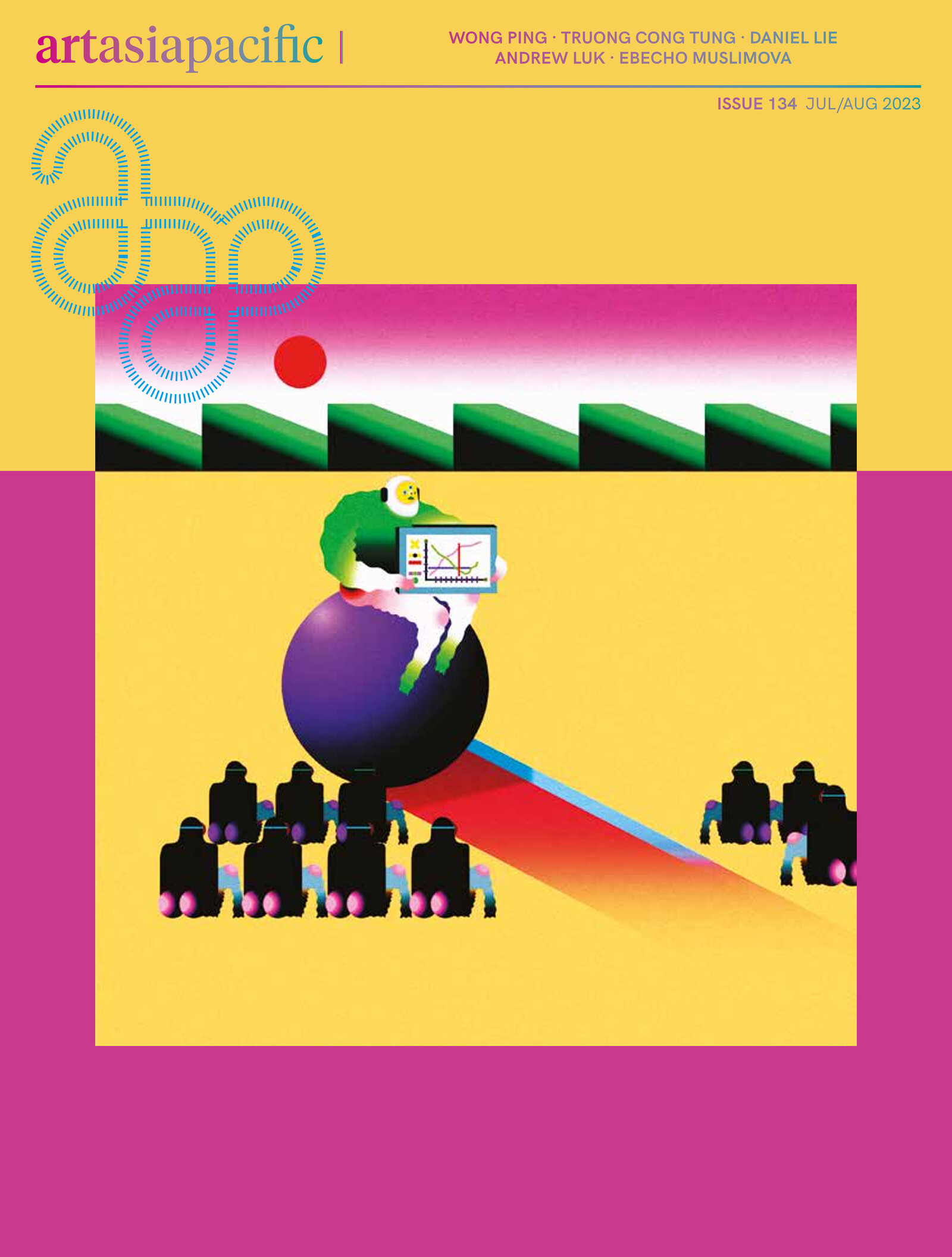Issue 134
The world around us informs how we make art, and why. In issue 134 of ArtAsiaPacific we hear from artists of multiple generations and geographies whose environments, whether urban or rural, digital or analog, frame the urgent topics that drive their practices.
Our cover Feature is firmly rooted in the context of the 21st-century Asian metropolis, where digital connectivity mediates daily interactions and social relations. Associate editor Pamela Wong caught up with Hong Kong artist Wong Ping to talk about the delirious effects of internet-dating apps on society and our personal desires and expectations for relationships. With a fluorescent palette—unfortunately difficult to reproduce on the printed page—and his lurid, confessional humor, Wong lets his visual imagination run wild in his animated short videos while simultaneously addressing social issues, whether it is care for the elderly or physical intimacy in a marriage.
We jump from the digital cosmos to an organic universe in our second Feature, an interview between writer and translator Dương Mạnh Hùng and the artist Truong Cong Tung, whose practice incorporates organic materials, a reflection of his upbringing amid the Dak Lak highlands of central Vietnam. They discuss Truong’s embrace of materials gathered from the forest as well as his use of found video footage and photographs that each carry their own spirits and energy.
In the second chapter of our ongoing collaboration with Asia Art Archive, we look back at a formative moment in 1990 when artists in Hong Kong—including Ellen Pau, Yau Ching, May Fung, and Lo Yin Shan—were considering their experiments in video art at the intersection of the gender politics of the day. Our Up Close selections for this issue spotlight a project about a neighbor’s garden by Simryn Gill at the Museum of Contemporary Art, Australia, in Sydney in The National 4 exhibition; Leung Chi Wo’s recent video-diary installation capturing sites in Hong Kong; and Oum Jeongsoon’s trunk-less elephant sculptures that garnered the artist a major prize at the 14th Gwangju Biennale.
The 50th edition of Inside Burger Collection is an interview by Mitchell Anderson with fellow artist Ebecho Muslimova about the lascivious character she dreamed up as an escape from her fine art studies, which eventually became the central figure in her paintings. In Essays, curator Kerstin Winking casts a look back at the Sharjah Art Foundation’s March Meeting 2023, where scholars, researchers, curators, and artists convened to consider the legacy of Okwui Enwezor. Manila-based contributor Dondie Casanova recounts visiting exhibitions that address the pending demise of the Philippines’s uniquely ornamented communal minibuses known as jeepneys. In Profiles, Berlin desk editor Clara Tang explores the life and practice of Daniel Lie and their interest in organic transformation and collaborating with “other-than- human-beings.”
Elsewhere in this issue, Han Mengyun penned the One on One about the influence of literary theorist Gayatri Chakravorty Spivak on her worldview and artistic practice. Writing from Ho Chi Minh City, Quyen Hoang looks at the conflicting currents of popular curiosity yet official ambivalence swirling in the art scene. In New Currents, we spotlight the emerging practices of Singapore-based Priyageetha Dia, Almaty-born Medina Bazarğali, and New York-based Kyung-Me.
In Reviews, we take a close look at the ambitions of the 14th Gwangju Biennale, “soft and weak like water,” to see how it measures up with other recent explorations of its central motif. Elsewhere we survey the late Masahisa Fukase’s retrospective in Tokyo and Kelly Akashi’s latest forays into the medium of glass recently on view in New York. Finally, in Where I Work, we visit multimedia artist Andrew Luk’s studio in Hong Kong where he was packing up as he prepares to embark on a new chapter in his practice. As writer and photographer Oliver Clasper describes his memories of seeing Luk’s previous studio, with its leaking walls and steady decay, he reveals the entropic forces that have run throughout Luk’s practice in recent years and locates there the convergences of historical resonances and the forces that drive our increasingly chaotic natural world.
A digital edition of the full issue is now available for purchase on Zinio, Google Play, the Apple App Store, and Magzter.
